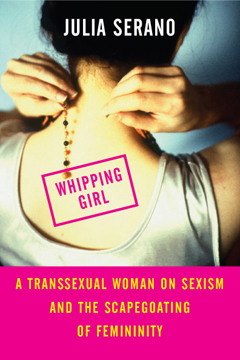
Transphobia consists of negative attitudes, feelings, or actions towards transgender people or transness in general. Transphobia can include fear, aversion, hatred, violence or anger towards people who do not conform to social gender roles. Transphobia is a type of prejudice and discrimination, similar to racism, sexism, or ableism, and it is closely associated with homophobia. Transgender people of color can experience many different forms of discrimination simultaneously.
Gender identity is the personal sense of one's own gender. Gender identity can correlate with a person's assigned sex or can differ from it. In most individuals, the various biological determinants of sex are congruent, and consistent with the individual's gender identity. Gender expression typically reflects a person's gender identity, but this is not always the case. While a person may express behaviors, attitudes, and appearances consistent with a particular gender role, such expression may not necessarily reflect their gender identity. The term gender identity was coined by psychiatry professor Robert J. Stoller in 1964 and popularized by controversial psychologist John Money.
Heteronormativity is the concept that heterosexuality is the preferred or normal sexual orientation. It assumes the gender binary and that sexual and marital relations are most fitting between people of opposite sex.
The following outline is provided as an overview of and topical guide to transgender topics.

A trans man is a man who was assigned female at birth. Trans men have a male gender identity, and many trans men undergo medical and social transition to alter their appearance in a way that aligns with their gender identity or alleviates gender dysphoria.
Gender expression, or gender presentation, is a person's behavior, mannerisms, and appearance that are socially associated with gender, namely femininity or masculinity. Gender expression can also be defined as the external manifestation of one's gender identity through behavior, clothing, hairstyles, voice, or body characteristics. Typically, a person's gender expression is thought of in terms of masculinity and femininity, but an individual's gender expression may incorporate both feminine and masculine traits, or neither. A person's gender expression may or may not match their assigned sex at birth. This includes gender roles, and accordingly relies on cultural stereotypes about gender. It is distinct from gender identity.
The gender binary is the classification of gender into two distinct forms of masculine and feminine, whether by social system, cultural belief, or both simultaneously. Most cultures use a gender binary, having two genders.

A transsexual person is someone who experiences a gender identity that is inconsistent with their assigned sex, and desires to permanently transition to the sex or gender with which they identify, usually seeking medical assistance to help them align their body with their identified sex or gender.

Transmisogyny, otherwise known as trans-misogyny and transphobic misogyny, is the intersection of transphobia and misogyny as experienced by trans women and transfeminine people. The term was coined by Julia Serano in her 2007 book Whipping Girl to describe a particular form of oppression experienced by trans women. In an interview with The New York Times, Serano explores the roots of transmisogyny as a critique of feminine gender expressions which are "ridiculed in comparison to masculine interests and gender expression."
Discrimination against non-binary people, people who do not identify exclusively as male or female, may occur in social, legal, or medical contexts.

Whipping Girl: A Transsexual Woman on Sexism and the Scapegoating of Femininity is a 2007 book by the gender theorist, biologist, and writer Julia Serano. The book is a transfeminist manifesto that makes the case that transphobia is rooted in sexism and that transgender activism is a feminist movement. The second edition of the book was published in March 2016.

The following outline offers an overview and guide to LGBT topics.

Intersex people are born with sex characteristics that "do not fit the typical definitions for male or female bodies". They are substantially more likely to identify as lesbian, gay, bisexual, or transgender (LGBT) than endosex people, an estimated 52% identifying as non-heterosexual and 8.5% to 20% experiencing gender dysphoria. Although many intersex people are heterosexual and cisgender, this overlap and "shared experiences of harm arising from dominant societal sex and gender norms" has led to intersex people often being included under the LGBT umbrella, with the acronym sometimes expanded to LGBTI. Some intersex activists and organisations have criticised this inclusion as distracting from intersex-specific issues such as involuntary medical interventions.
LGBT erasure refers to the tendency to intentionally or unintentionally remove LGBT groups or people from record, or downplay their significance, which includes lesbian, gay, bisexual, transgender, and queer people. This erasure can be found in a number of written and oral texts, including popular and scholarly texts.

Military service of intersex people varies greatly by country. Some armed forces such as the Australian Defence Force fully embrace intersex people in the modern era, while others such as the United States Armed Forces have vague rules or policies or treat the subject on a case by case basis.
Homonormativity is the adoption of heteronormative ideals and constructs onto LGBT culture and identity. It is predicated on the assumption that the norms and values of heterosexuality should be replicated and performed among homosexual people. Those who assert this theory claim homonormativity selectively privileges cisgendered homosexuality as worthy of social acceptance.
An endosex person is someone whose innate sex characteristics fit normative medical ideas for female or male bodies. The word endosex is an antonym of intersex.
Discrimination against transgender men and transmasculine individuals, sometimes referred to as transandrophobia, anti-transmasculinity, or transmisandry, is a similar concept to transmisogyny and discrimination against non-binary people. Transmisogyny, discrimination against transgender men and discrimination against non-binary people are types of transphobia which affect trans women, trans men and non-binary people respectively.
Cisnormativity or cissexual assumption is the assumption that everyone is, or ought to be, cisgender. The term can further refer to a wider range of presumptions about gender assignment, such as the presumption of a gender binary, or expectations of conformity to gender roles even when transgender identities are otherwise acknowledged. Cisnormativity is a form of cisgenderism, an ideology which promotes various normative ideas about gender, to the invalidation of individuals' own gender identities, analogous to heterosexism or ableism.







